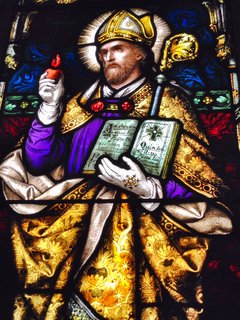The Road to Sainthood
By Caitlin Bootsma
Consultant to the VIRTUS® Programs
 process by which people become saints and we're looking forward to sharing more about these holy men and women.
process by which people become saints and we're looking forward to sharing more about these holy men and women.If you have any additional feedback about the types of articles you would like to see here, please do not hesitate to contact editor@virtus.org.
While we all know and pray for the intercession of the saints, the process of becoming a saint may not be as familiar. Canonized saints are men and women who the Church recognizes as being in Heaven with God. While hopefully there are many, many saints, including some among our deceased family and friends, the Church is very careful about who She holds up for public recognition. It should come as no surprise, then, that being canonized is not a “given”, but rather a process that clearly demonstrates the holiness of each individual.
For your own knowledge, and also to share with the people you serve, here are the steps that must be completed before the canonization of a new saint.
1. A five-year waiting period: To ensure that the deceased person has a lasting reputation for holiness, a cause for canonization cannot begin until the person has been dead five years. A Pope can waive this requirement. This happened recently with both (Saint) Mother Teresa and (Saint) Pope John Paul II.
2. Servant of God: After the waiting period, the diocese in which a person died can begin a cause for canonization. Once this stage has begun, the person is known as a Servant of God. During this time, the diocese gathers a great deal of information about the Servant of God—both about their life and from any writings they may have produced. Once the documents have been examined by the diocesan tribunal and the bishop and the person has been found worthy, the cause (and all of the documentation!) is sent to the Vatican, particularly to the Congregation for the Causes of the Saints. The Congregation processes the documentation and the work of the diocese and ultimately votes whether the Servant of God’s cause should continue. If they decide the cause should continue they send a “Decree of Heroic Virtues” to the Pope who decides whether or not to continue the process. The length of time that this process takes does not necessarily correlate to a Servant of God’s holiness, but rather to the ability to collect and decide upon documentation. Dorothy Day is just one example of many men and women who are currently Servants of God.
3. Venerable: If the Holy Father approves of the “Decree of Heroic Virtues” the man or woman then becomes known as “Venerable”. As a side note, it is possible for a person never to advance past this stage (such as the Venerable Bede) because more absolute evidence of their holiness was never confirmed. The evidence of holiness is, at this stage, proven by a miracle that occurred because of the Venerable’s intercession. This miracle must be something a theological commission establishes occurred after praying specifically for the Venerable’s assistance and that could not have been accomplished through natural causes. Once the theological commission has voted and made a positive determination of a miracle, they pass along the cause again to the Congregation for the Causes of the Saints. If the Congregation votes that a miracle occurred, the cause is given to the Holy Father.
4. Beatification: If the Holy Father approves of the Decree of a Miracle, the Venerable can then be Beatified and known as a Blessed. At this point, the faithful are able to venerate the Blessed, particularly in the Blessed’s local diocese. Blessed Paul VI is just one example of a person recently beatified by Pope Francis. Once a person is beatified, the process begins to confirm a second miracle. If a second miracle is verified, and approved by the Pope, the Blessed qualifies to be canonized a saint.
5. Sainthood: The Pope then canonizes the man or woman a saint. Of course, canonization does not “make a saint”, but rather recognizes infallibly that the person is already in heaven. Once a saint is canonized, the universal Church is invited to pray for their intercession.
Canonizations can be a long process. However, the process ensures that we, the faithful, know that we have intercessors in heaven, praying that we will also one day enjoy eternal life.
N.B. The process for canonization for someone who has been martyred is slightly different. When someone dies for God, as Catholics, we believe they go directly to heaven. Thus, we do not need to confirm that a miracle occurred through their intercession since we already know they are in heaven.
This article is not part of your continuing training. To access your required bulletins you must log in using the form in the upper left-hand corner of the screen. Then go to the TRAINING tab.



